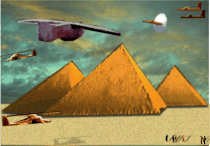Dinosaurs in Literature, Art & History--First or Second Century B.C. Colima Toad,
or Ankylosaur?... Page 31

Here at s8int.com, we know that there's probably no less exciting "dinosaur" than the ankylosaur ---but here again we use this particular distinctive animal to prove that man and "dinosaur" co-existed, just as the Bible tells us.
Sure, we wish we had a first century example of a t-rex, but today we have to deal with what we have. (we do have more interesting examples on prior pages of this section)
The item shown below from several angles was offered for sale online. The company selling it "knows" that ankylosaurs died out 65 million years ago, according to scientists who study such things. Therefore, this has to be a toad, (for which there is some resemblance, we suppose) which did still exist more than 2,500 years ago.
They describe it first as a toad and then later in the text as a "reptile". Of course, toads are not reptiles, they are amphibians. Anklyosaurs were reptiles, however, but we're probably just being picky.
Below we provide; the auctioneer's full description, photos of the object in question, a picture of some actual toads, as well as a synopsis of what science says about the anklyosaur. You'll have to decide for yourself if this is a Colima culture toad, --or a dinosaur.
Frankly, we think toads will be insulted by the comparison.



Colima Horned Toad
(actual toads left, Colima object below, center)
Protoclassic, ca. 100 B.C. to A.D. 250.
Height: 5.3 in. (13.5 cm.); Length: 10.5 in. (26.7 cm.).
Price: $2,250
Protoclassic, ca. 100 B.C. to A.D. 250, with burnished reddish-brown slip. There are four rows of spiked protrusions in high relief along the length of the body, and one row across the head, thirty in all.
Coffee bean eyes, recessed nostrils, open mouth, spout as tail, and short legs create a reptile that seems pleased with his surroundings.
Condition: One spike is chipped, and there is a very small chip on the surface of the left side of the back. He is in otherwise excellent condition.
Provenance: From a Riverside County, California
Collection.
Height: 5.3 in. (13.5 cm.); Length: 10.5 in. (26.7 cm.).

Click and drag photo to resize.


Click and drag photo to resize.


Click and drag photo to resize.


"Ankylosaurus (Euoplocephalus is a type of anklylosaurus)
was a huge armored dinosaur, measuring about 25-35 feet (7.5-10.7 m) long, 6 feet (1.8 m) wide and 4 feet (1.2 m) tall; it weighed roughly 3-4 tons.
Its entire top side was heavily protected from carnivores with thick, oval plates embedded (fused) in its leathery skin, 2 rows of spikes along its body, large horns that projected from the back of the head, and a club-like tail.
It even had bony plates as protection for its eyes. Only its under-belly was unplated.
Flipping it over was the only way to wound it.
Ankylosaurus had four short legs (the rear legs were larger than the front legs), a short neck, and a wide skull with a tiny brain.
WHEN ANKYLOSAURUS LIVED
Ankylosaurus was the last of the ankylosaurids (armored dinosaurs) to evolve, and the biggest. It lived in the late Cretaceous Period, about 70-65 million years ago. Ankylosaurus and all the other dinosaurs (except birds) perished in the Cretaceous-Tertiary extinction, 65 million years ago."..(????)
Source: http://www.enchantedlearning.com

1, 2, 3, 4, 5, 6, 7, 8, 9, 10
11, 12, 13, 14, 15, 16
17 18, 19,
20,
21,
22,
23,
24,
25,
26,
27,
28,
29,
30,
31,
32,
33,
34,
35,
36,
37,
38,
39,
40,
41,
42,
43,
44,
45,
46,
47
Next>>>


 Home
Home 20th Century Dinosaurs
20th Century Dinosaurs Dinosaurs in Literature, Art & History
Dinosaurs in Literature, Art & History Eyewitness Accounts
Eyewitness Accounts There Were Giants In The Earth in Those Days
There Were Giants In The Earth in Those Days Mega Fauna
Mega Fauna Those Sophisticated "Cave Men"
Those Sophisticated "Cave Men" Search for Noah's Ark
Search for Noah's Ark DNA, The Ultimate Oopart
DNA, The Ultimate Oopart The Bone Yards
The Bone Yards Underwater Cities, Monuments?
Underwater Cities, Monuments? Ancient Atomic Knowledge?
Ancient Atomic Knowledge? Salvation. What Must You Do To Be Saved?
Salvation. What Must You Do To Be Saved? Search
Search Links
Links Guestbook
Guestbook



